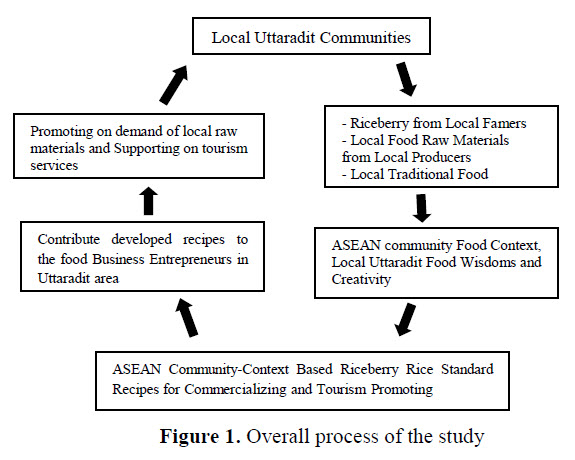The Development of Local Based Riceberry Rice Standard Recipes to Promote Commercialization and Tourism in the ASEAN Community
Keywords:
Riceberry rice, Standard food recipe, Community-context, Commercialization, ASEAN Community, Tourism promotionAbstract
This research is in the sequence of the innovative utilization from a previous study on developing standard food recipes utilizing Riceberry rice as the key ingredient under the context of the communities of Uttaradit province, Thailand along with the context of the ASEAN Community. The 10 standard recipes from the previous study were used in real commercialization that aimed to promote the utilization of local food raw materials of Uttaradit province, to increase the competitiveness of local products in the ASEAN Community’s market, and to promote commercialization and tourism. The recipes were tested on sensory acceptance evaluation with 100 tourist samples and nutritional values assessment. The evaluation data were used to indicate the potential of the recipes to meet tourists’ satisfaction, which was eventually used together with the recipes’ nutritional data as the reference for the consideration of and selection for one month of real commercialized trial testing by seven food business entrepreneurs in Uttaradit province. After finishing the commercialized test, the food business entrepreneurs evaluated the appropriateness of the recipes to use for real commercialization. The result of the average sensory acceptance evaluation scored on all 10 recipes using a 5-point hedonic scale evaluation form indicated that, all 10 recipes were accepted by the tourists and had the potential to be utilized for serving to tourists. The seven food business entrepreneurs selected four out of the 10 recipes for the commercialized test according to the reference data of each recipe provided for their consideration, flexibility, convenience and capability to adopt the recipes. The reasons that the entrepreneurs selected only four recipes were because of their consideration on the available raw materials during the testing period, their capability to cook the food according to the instruction of the recipes, and the conforming of the theme of the recipes to their business theme that mostly sold healthy food. The results of the recipes’ appropriateness for real commercialization using a Likert-type scale appropriateness evaluation form have shown that the selected recipes were appropriate for use in a real commercialization situation.
References
Association of Southeast Asian Nations. (2016, December 12). Retrieved from http://asean.org/?static_post=tourism-statistics
Bank of Agriculture and Agricultural Co-operatives, Uttaradit Branch. (2014). Riceberry Rice Cultivation in Uttaradit Province. Uttaradit,
Thailand.
Bunnak, A. (2016, November 20). The Factors Affecting the Southern Local Food Consumption of Thai Tourists, Retrieved from http://www.culturalapproach.siam.edu/images/mag azine/w15ch28/3-16.pdf.
Bureau of Nutrition. (2001). Nutritive Values of Thai Foods. Bangkok: Ministry of Public Health.
Chaima, K., & Toosaranon, C. (2012). Research on Development of Lanna Culture Local Food in Uttaradit Province. Uttaradit, Thailand :
Uttaradit Rajabhat University.
Kawanobe, S. (2001). The Motivation and Behaviour of Thai Tourists: Case Study of Muang District, Nan Province, (Master’s Thesis), Rajamangala University of Technology Thanyaburi.
Mintel Group Ltd. Global Food and Drink Trends 2016. Accessed October 23, 2016. http://www.mintel.com/global-food-and-drinktrends-
Panyayong, C. (2015). Study of Food Culture and Establishment of Standard ASEAN Cuisine Recipes for the ASEAN Economic Community
(AEC). (Full Paper Proceeding). 11th International Conference on Humanities and Social Sciences 2015 (IC-HUSO 2015) at Khon Kaen University, Thailand, 578-588.
Panyayong, C. (2016). Study of ASEAN Food Culture for the ASEAN Socio - Cultural Community, Journal of the Institute of Culture and Arts. Srinakharinwirot University, 18(1), 43 -52.
Panyayong, C. & Chatjaroenchaikul, W. (2016). Standard Cuisine Recipes Utilizing from Communities Context Based on Tha-Nueh Cultural to Promote the ASEAN Economic Community. Journal of Graduate Studies in Humanities and Social Science. Khon Kaen University, 5(1), 179-207.
Rice Science Center of Kasetsart University. (2016). Rice berry Rice. Retrieved from http://dna.kps.ku.ac.th/index.php/articles-ricersc-rgdu-knowledge/29-2015-03-27-02-04-15/53-riceberry.
US Department of Agriculture. National Nutrient Database for Standard Reference Release. Accessed October 23, 2016. http://ndb.nal.usda.gov/ndb/foods. Vagias, W. M. (2006). Likert-type scale response anchors. Clemson International Institute for Tourism & Research Development, Department of Parks, Recreation and Tourism Management. Clemson, SC: Clemson University.
Pannangrong, W., Wattanathorn, J., Muchimapura, S., Tiamkao, S., & Tong-Un, T. (2011). Purple Riceberry Is Neuroprotective and Enhances
Cognition in a Rat Model of Alzheimer's Disease. Journal of Medicinal Food. 14(7): 688-694.













